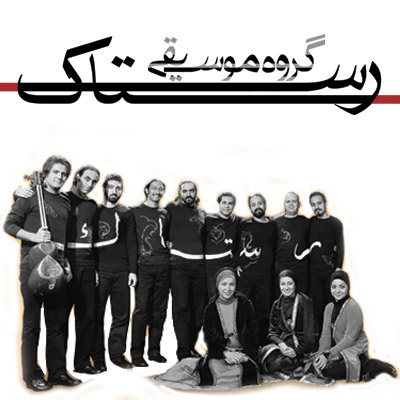 |
| Abdi Behravanfar |
I was born on June 1975. I got familiar with music from childhood, not through academic courses but by listening to Western and Persian music excessively. At 12, by watching ‘roll on ‘the song of the country band named 'Alabama’ I found that I love to play guitar. One night I dreamed a room full of guitars that a few years later my dream abecame true while nobody lived there anymore except two dogs. While loneliness at that home, still, there was sound that had not disappeared and this time through bass and guitar’s strings, big drum and two dogs.
It was the right moment that yellow angel had arrived, the sound annoyed surrounding. Police, the old friend, seemed an easy matter .Seven months before Helal Ahmar performance, I met Mustafa Yavari. He was dark and despite of being young, he seemed old apparently and inwardly. Mustafa by writing his poems and expressing a pure feeling of Rock not separated from his own real life, had great effect on me. Mustafa died 2 months after Helal Ahmar concert on his birthday.The yellow dog also left 2 months later and the black dog was stolen with his collar.
Then I left the house too and took with me the hollow trunk of quince and Agha Ghazanfar’s stone grave for remembrance. The little garden’s grass ended up, in autumn .The great silence ruled over the house for one year and then the place became a hole.
I went Tehran and worked in a construction work shop and there the song ‘Kargar e Badbakht’ was formed. At the same time I had the experience of making music for two plays named ‘what you hear is a tuneless instrument of silence’ and I also made music for a long film named ‘Yellow wall paper’.
The decade of 80’s: war, Ahangaran, joining Islamic society of school, break dance, thriller, dead dance, mixture of a noisy distressing family and my interest for playing guitar which sum up to a racket.
Considering society and family, Metal was a tranquillizer for me and ‘the edge of darkness’ by Eric Clapton suddenly exploded the whole school with Plutonium.
By the time I was 22, after getting familiar with a professor of New York Poly Techniques University, and giving me a diverse training in various fields, I bought a Guitar, the wood that seemed most necessary to me of all things and people.Mr Farhady was one of the biggest influences on my playing and the reason I bought the guitar.Rock’s screaming, another religion named Blues, Metal’s non stop crying, Country’s greenness, and depth of Folk music.
As I was studying industrial engineering in Tehran, I bought the broken accoustic guitar and Fleming Khoshghadami gave me my first guitar lessons, in Country and Blues styles. I learned the basics of playing harmonica with him too. After a while the Fleming concert was held at Farabi hall with my management which was the first Country music performance after years in Tehran.
Then I took a short term class with Kamran Yaghmayee to learn electric guitar techniques especially in Blues and Rock styles.
After getting back to Mashad in order to set up a rock band, I met different people playing music; as a result a concert was held, covering Blues and Rock songs.
After first concert, I concentrated more on group rehearsal; thus was set up a band named Mud. Because of rehearsals, the band’s members and I learned different music styles through practical experience.This life with music had great influence on the kind and way of making songs.Sometimes my own experiences combine with others’ experiences and made my music.
In my way, I learned a lot from great musicians, Rock(Jimi Hendrix, Janis Joplin, Jim Morrison), Blues( Son House, Muddy Waters, Sunny Boy Williamson ), Jazz(Charlie Parker, John Coltrane ),Country and Folk (Neil Young, Ian Anderson).
Getting familiar with these legends was mostly because of selling CDs for a long time. For a while I got busy with selling toilet stone, crystal palace and my everlasting friend of lonesome days.
Creating and bringing to existence comes from the life and way of living; also, in all music styles the instruments are in service of players to show musicians’ feelings toward their immediate surroundings, not in a complete vacuum of not listening and not seeing; naturally it’s not possible to react and show feeling just with knowing techniques and learning academically.
In 2006 I moved to Armenia to study Jazz; consequently I experienced playing at bars and cafes, even at metros and sidewalks; furthermore 4 concerts were held.
After getting back to Mashad, When I recorded the album named ‘Shalamroud’ , I was learning Dotar with Ali Gholamrezayee Almajughi and it was accompanied with learning the ancient folk tales of Iran which caused my closeness toward Maghami and folk music,and it had its effect on the album’ Kokheo & Kalakhet’. The two albums "Shalamroud"and Kokheo&Kalakhet" released by two production companies in the United states.The first one by Bamahang production and the second album released by Zirzamin production.Also the two CDs are available on www.cdbaby.com to buy.
I started learning Ghoshmeh with Ali Akbar Bahari Knowing Iranian Folk instruments is an opening to me toward knowing Folk and Maghami music and practically acquaintance with Bakhshies and Asheghs.Learning heart by heart from khorasan great Folk players had its effect on me, not only playing folk instruments but also using them with Rock and Blues orchestras.
Till now many concerts , and made more than 40 songs that some are recorded and some performed; also I made music for short and long films and plays. (By Abdi Behravanfar from
Abdi Behravanfar's Official Website)
 |
| Kokheo & Kalakhet |


















